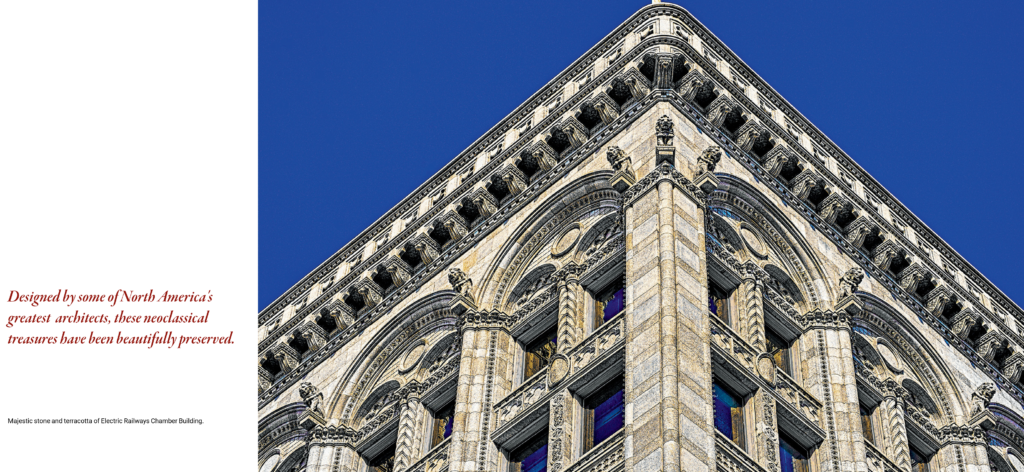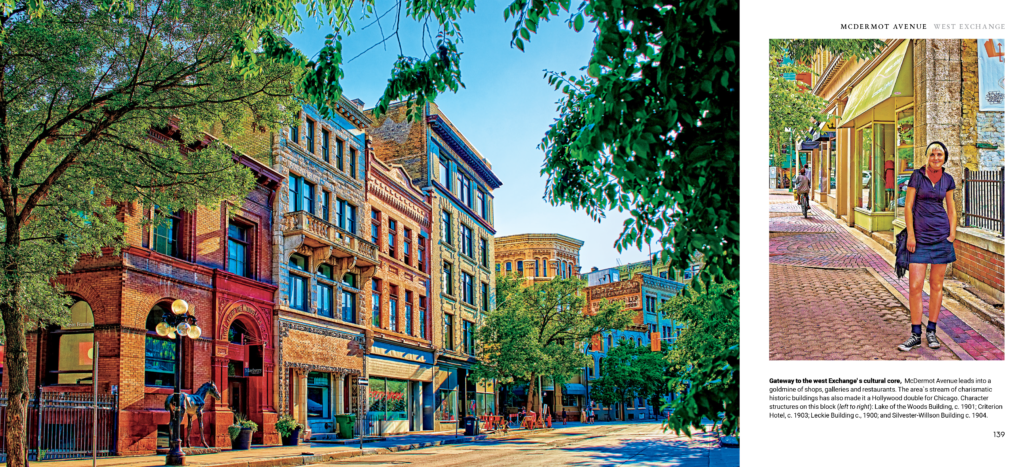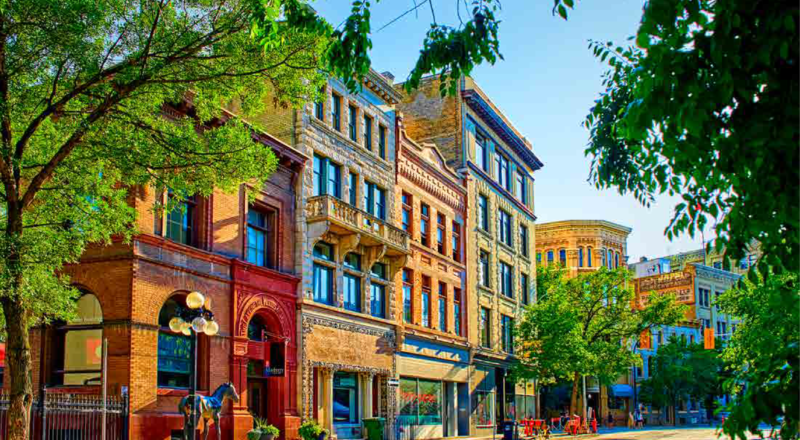
/ Blog
May 27, 2021
Capturing the Magnificent Exchange District!
There is something about the Exchange District that captures peoples imaginations; from tourists, filmmakers, entrepreneurs and artists, to all the people who call the neighbourhood home. The Exchange District is the former warehouse section of Winnipeg, which has evolved and adapted over the past 150 years to become a hub of arts and culture, filled with local shops and creative spaces, all housed within stunning photogenic historic buildings. As the sun rises over the Exchange District each morning, blanketing a symphony of architecture in golden light, it is the portrait of contentment; a charming medium density, a human scale neighbourhood filled with an urban forest, mixing commercial, institutional and residential uses with ease. Around every corner is another picture perfect vista, inviting you to pause and admire, contemplating the tumultuous history it has witnessed. Set in a foundation of robust rough cut stone, the Exchange District has gone from rags to riches and back again, seemingly unshakable in its ability to stand the test of time and capture our hearts.

“Tree-lined Albert Street stretches south through the West Exchange, back dropped by historic downtown Winnipeg banks and new office towers in this rooftop view from the area’s central Artspace building. Although but a portion of the district, this collection of early-20th-century buildings houses scores of busy boutiques, galleries, and unique award-winning restaurants.”
Source: Treasures of Winnipeg’s Historic Exchange by George J. Mitchell, pages 22-23
It is this charm that caught the attention of photographer George Mitchell, whose book, Treasures of Winnipeg’s Historic Exchange, was published in January of 2021. Full of lush photographs of the Exchange District, the book represents ten years and thousands of hours of hard work. In it, Mitchell, a former publications manager with Sun Media, sought to capture both the rich architectural history and the thriving community within the Exchange District. Spectacular stone and terracotta, spaces not open to the public, ghost signs, graffiti, street life and more, burst from the pages in electrifying colours and with beautiful details that delight the eyes and uplift the soul.

George Mitchell’s beautiful book, Treasures of Winnipeg’s Historic Exchange, is available for purchase in the Heritage Winnipeg store for 25% off the regular retail price! All proceeds help Heritage Winnipeg advocate for and celebrate Winnipeg’s built heritage.
Source: Treasures of Winnipeg’s Historic Exchange, by George Mitchell, front cover
According to Mitchell, the Exchange District first “came to life” for him about ten years ago – while parking his car on McDermot Avenue across from the Albert Block.
“Of course as a lifetime Winnipegger I had visited the Exchange countless times, but that day my eyes opened,” Mitchell continued. “Something made me aware of how captivating the experience could be…historic architecture sprawling for blocks, beautifully preserved and re-purposed, weekend visitors communally taking in the atmosphere—truly a place apart and another superb dimension of the city’s personality”.
From that point on I began exploring with my cameras, usually carrying two at a time, looking for what made the Exchange so compelling, the elements of its appeal. I didn’t have a plan or timetable. It was my go-to place, extremely photogenic, full of life, with hundreds of vantage points, and unique happenings to discover simply by being there for thousands of pleasant hours.
The idea of a book emerged as the volume of work grew. At some point I had taken a “critical mass” of photos, and an Exchange book seemed possible. During one particularly resplendent Saturday-afternoon sun shower that glossed the Romanesque terracotta, I added several double-spread-worthy photos within an energized hour. I had struck gold.”

“Majestic stone and terracotta of Electric Railways Chamber Building.”
Source: Treasures of Winnipeg’s Historic Exchange by George J. Mitchell, pages 5-6
Over 300 vibrant images of the Exchange District fill up the pages in Mitchell’s best selling book, contextualized with fun facts and histories of the buildings photographed. Archival photos compliment and contrast the present day Exchange District to the more industrial warehouse it was in the past. Originally, in the years prior to Winnipeg’s incorporation as a city, the Exchange District was part of the Red River Settlement. Smaller houses and boom town storefronts made up the bulk of the buildings in the area, until, that is, Winnipeg was incorporated as a city in 1873, and the railroad reached Winnipeg in 1883. The area began to shift as Manitoba’s economy did, with warehouses replacing homes to accommodate wholesalers and grain merchants who flocked to downtown Winnipeg. This economic excitement lasted until the 1920s, when the Panama Canal, First World War and a wider economic downturn slowed Winnipeg’s growth. Garment manufacturers moved in next, snatching up former warehouses at low prices, and they would operate in the area until the 1960s and 70s. This was an era of economic revitalization, of an ‘out-with-the-old’ mentality that led to the demolition of a number of historic structures in the East Exchange and along Main Street. Although this also resulted in a collection of unique Brutalist structures.
Treasures of Winnipeg’s Historic Exchange presents a neighbourhood full of life, and excitement, and history and of course, that is what the Exchange District is. This is the community that is home to the Winnipeg Fringe Festival, Winnipeg Jazz Festival and countless other events big and small. Film crews flock to the area to shoot anything from action thrillers (such as 2021’s Nobody) or quaint Hallmark Christmas movies. These events and projects make important contributions to Winnipeg’s economy, drawing people in with the timeless architecture and endearing public spaces. It stands to reason that such a local treasure should be protected – but this is not always the case.
After many years of hard work by Heritage Winnipeg and other organizations, the Exchange District was designated a National Historic Site in 1997. The area was given this recognition because it “contains a range of architecturally significant built resources which speak to the city’s key economic role in the West and the collective character of these built resources is distinct and relatively intact… utilizing contemporary construction methods and architectural styles.” But this important title affords no real protection to the neighbourhood, preventing neither alternation or demolition. That responsibility is instead left to the City of Winnipeg, which designates heritage buildings on an individual basis and also regulates new construction. Although many of the buildings in the Exchange District have become designated, some are not, leaving them as risk of being lost. The former Reliable Service Station at 98 Albert Street is an example of such a building, having stood at the prominent intersection in the area since 1925. It was denied the protection of a heritage designation and sadly demolished to make way for a modern building in 2019, also resulting in the loss of trees and an significant historic streetscape! The recent infill proposal at 127 Bannatyne Avenue is equally problematic, with little regard for its historic surrounding in terms of height and design. Thankfully the project request was denied by the city, but everyone is hopeful something sympathetic can be developed.

“Gateway to the West Exchange’ s cultural core, McDermot Avenue leads into a goldmine of shops, galleries and restaurants. The area`s stream of charismatic historic buildings has also made it a Hollywood double for Chicago. Character structures on this block (left to right): Lake of the Woods Building, c. 1901; Criterion Hotel, c. 1903; Leckie Building c., 1900; and Silvester-Wilson Building c. 1904.”
Source: Treasures of Winnipeg’s Historic Exchange by George J. Mitchell, pages 138-139
While Mitchell’s photography captures a frozen moment in time in the Exchange District, in reality the neighbourhood is never still – it is a living, breathing entity, constantly adapting to ever changing conditions in order to remain economically viable. But that does not mean change needs to be charged into with reckless abandonment, throwing all caution to the wind. Successful change needs to embrace what makes the Exchange District great, while catering to the needs of a modern community. Short buildings once limited in height due to construction methods of the time, now are recognized for making an appealing, human scale neighbourhood, as opposed to a cold, imposing concrete jungle. Short blocks with large shady trees invite people to take a stroll, while unique architecture creates a sense of place that makes you feel at home. Large shop windows, ample entrances and lively street life, contributes to a feeling of security and enhances the atmosphere of excitement. Adaptive reuse ensures the environmental sustainability of the area and provides local jobs in construction and maintenance. A mix of commercial and residential spaces, large and small, refurbished and antiquated, nurture a diverse community, that meets the needs of people from all walks of life. These are the characteristics of the Exchange District that should be conserved and celebrated. As the world reawakens after an unprecedented pandemic in 2020, we must approach change in the Exchange District with respect for the past, present and future; consulting stakeholders, honouring the historic context, and ensuring its viability for another century. It is no small task, but Winnipeg’s Exchange District is a true gem that deserves to be treasured!
George Mitchell’s beautiful new book, Treasures of Winnipeg’s Historic Exchange, is available for purchase in the Heritage Winnipeg store for 25% off the regular retail price! All proceeds help Heritage Winnipeg advocate for and celebrate Winnipeg’s built heritage.
Special thanks to George Mitchell for his wonderful insights and help in the research of this blog!
THANK YOU TO THE SPONSOR OF THIS BLOG POST:

Written by Heritage Winnipeg.
SOURCES:
"The Challenge of Change: The Reliable Service Station" (Heritage Winnipeg)
"Exchange District National Historic Site of Canada" (Government of Canada)
George Mitchell, “Treasures of Winnipeg’s Historic Exchange”
“New Book Highlights Winnipeg’s Historic Chicago-Style Architecture” (Heritage House Publishing)
“Winnipeg Bestsellers For April 4 - 14” (McNally Robinson)











